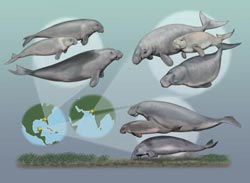Smithsonian scientists discover that multiple species of seacows once coexisted

Sirenians, or seacows, are a group of marine mammals that include manatees and dugongs; Today, only one species of seacow is found in each world region. Smithsonian scientists have discovered that this was not always the case. According to the fossil record of these marine mammals, it was more common to find three or more different species of seacows living together at one time. This suggests that the environment and food sources for ancient seacows were also different than today. Credit: Carl Buell<br>
Smithsonian scientists have discovered that this was not always the case. According to the fossil record of these marine mammals, which dates back 50 million years ago, it was more common to find three, or possibly more, different species of seacows living together at one time. This suggests that the environment and food sources for ancient seacows were also different than today. The team's findings are published in the journal PLoS ONE.
Today there are only four species of seacows¯three species of manatees, which are found in different coastal waters of the Atlantic Ocean, and one species of dugong, found along the coasts of the Indo-Pacific Ocean. All seacows are herbivores, and their diet is made up largely of seagrasses.
“The discovery that these multispecies seacow communities once existed revealed answers, but it also created new questions,” said Nicholas Pyenson, curator of fossil marine mammals at the Smithsonian's National Museum of Natural History and co-author of the research. “Were these species competing against each other for seagrass resources, or were they avoiding competition by each species feeding in separate areas or on different grasses? Also, were seagrass beds structured differently in the past, or were they dominated by one seagrass species like we see today?”
To answer these questions, the team, lead by Smithsonian predoctoral fellow Jorge Velez-Juarbe, examined three localities from separate time periods, from the late Oligocene (about 23-28 million year ago) in Florida, the early Miocene (about 16-23 million years ago) in India and the early Pliocene (about 3-5 million years ago) in Mexico. All three areas showed conclusive fossil evidence that two or more species of seacow had once coexisted there.
By examining the size and dimensions of the skulls as well as estimating the body sizes, the team deduced that the different species of seacows had characteristics that allowed each to feed on different types of seagrass. Such separation among physical features, the team suggests, reduced any competition for food and allowed multiple species of seacows to coexist. This also suggests that, unlike today's seacow habitats that are dominated by one or two species of seagrass, many species of seagrass once coexisted.
Media Contact
More Information:
http://www.si.eduAll latest news from the category: Life Sciences and Chemistry
Articles and reports from the Life Sciences and chemistry area deal with applied and basic research into modern biology, chemistry and human medicine.
Valuable information can be found on a range of life sciences fields including bacteriology, biochemistry, bionics, bioinformatics, biophysics, biotechnology, genetics, geobotany, human biology, marine biology, microbiology, molecular biology, cellular biology, zoology, bioinorganic chemistry, microchemistry and environmental chemistry.
Newest articles

Superradiant atoms could push the boundaries of how precisely time can be measured
Superradiant atoms can help us measure time more precisely than ever. In a new study, researchers from the University of Copenhagen present a new method for measuring the time interval,…

Ion thermoelectric conversion devices for near room temperature
The electrode sheet of the thermoelectric device consists of ionic hydrogel, which is sandwiched between the electrodes to form, and the Prussian blue on the electrode undergoes a redox reaction…

Zap Energy achieves 37-million-degree temperatures in a compact device
New publication reports record electron temperatures for a small-scale, sheared-flow-stabilized Z-pinch fusion device. In the nine decades since humans first produced fusion reactions, only a few fusion technologies have demonstrated…





















